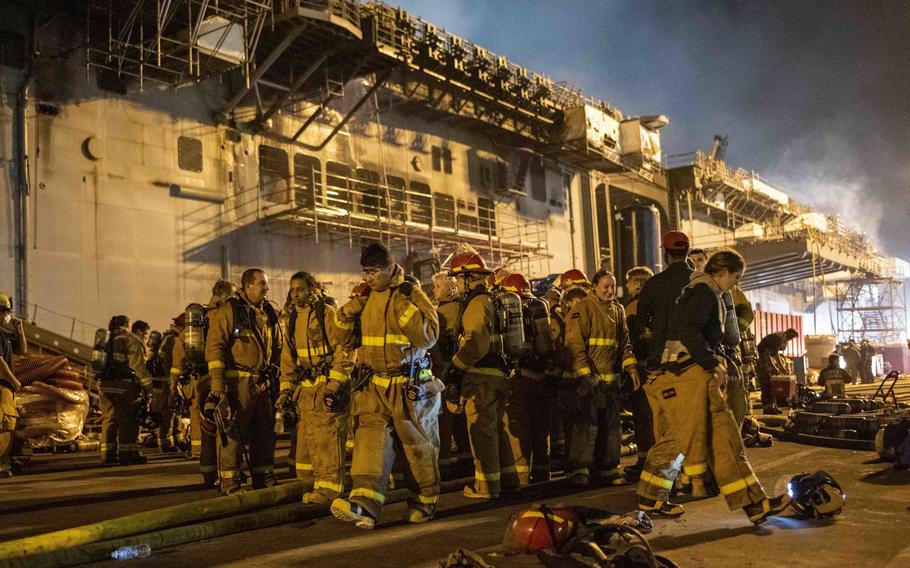
Sailors combat a fire aboard the amphibious assault ship USS Bonhomme Richard (LHD 6). On the morning of July 12, 2020, a fire was called away aboard the ship while it was moored pierside at Naval Base San Diego. Base and shipboard firefighters responded to the fire. (Hector Carrera/U.S. Navy)
WASHINGTON — The second highest ranking admiral in the Navy explained Wednesday what the service must do to prevent another major ship fire like the one aboard the USS Bonhomme Richard that gutted the amphibious assault ship last year in San Diego.
Adm. Bill Lescher, vice chief of naval operations, said the force must create “better mechanisms to recognize when our people need help or need intervention” with firefighter training after a report on the July 2020 fire released Wednesday found the Bonhomme Richard crew was unprepared to fight the flames.
“We saw that our ships meet high firefighting stands at sea, but when they transition to and from the maintenance phase, they face different hazards and challenges,” Lescher told reporters Wednesday during a news briefing.
The report found the crew’s “lack of familiarity” with firefighting protocol and inability to work with civilian firefighters “led to an ineffective fire response” that caused the ship to become “damaged beyond economical repair.” For example, the crew did not know how to use the ship’s main firefighting foam system and did not ring the ship’s alarm bell until 10 minutes after finding the fire.
The Navy on Wednesday also released a major fires review report, commissioned in January, that examined fires that the service has had during the past 12 years. That report found “ineffective learning,” persistent watch-standing weaknesses, improper hazardous and combustible material stowage and poor training contributed to “a lack of enduring change and in shipboard fires.”
The Bonhomme Richard was undergoing a two-year, $249 million maintenance period when it went up in flames. The Navy said the fire was set by a disgruntled crew member, Seaman Apprentice Ryan Sawyer Mays, 20.
The fire burned through 11 of the ship’s 14 decks, destroyed its forward mast and damaged the superstructure before it was extinguished, causing the Navy to decommission the vessel in April. Mays was charged in August with aggravated arson and the willful hazarding of a vessel.
“Although the fire was started by an act of arson, the ship was lost due to an inability to extinguish the fire,” according to the Bonhomme Richard report. “In the 19 months executing the ship’s maintenance availability, repeated failures allowed for the accumulation of significant risk and an inadequately prepared crew.”
Calling the fire “clearly preventable,” Lescher said the Navy needs to ensure lessons learned from similar fires are implemented.
“This is unacceptable. Bonhomme Richard was not the first major fire that resulted in the loss of a capital Navy ship,” he said. “(The report) clearly illuminated that the Navy has not been consistently effective in sustaining corrective actions from previous fires over time.”
To address that problem, the major fires review offered seven strategic recommendations to ensure the lessons stick. The recommendations include improving operational safety programs, addressing “the unabated threat of arson,” reviewing shipyard fire safety processes and enforcing “a much higher standard for shipboard stowage of both combustible and hazardous materials.”
The report also recommended a revamp of the Naval Safety Center to create a “more effective organization” responsible for “establishing policy, conducting investigations, assessing trends” and overseeing implementation and enforcement of safety standards.
“Through this work, the naval safety command will provide an ongoing, comprehensive view of the Navy safety posture and promote compliance and evaluate whether lessons learned and best practices are being implemented, sustained and shared across the Navy,” Lescher said.